The Oquendo class Destroyers are a rare case: Post-WW2 Spain years were not favourable for new naval plans or ship construction, and yet, the Spanish destroyer force was near obsolete. Apart Liniers and Álava completed to a new design in 1946-1947, the Audaz class destroyers (9 ordered in March 1944) were completed as frigates in the 1950s. But worst still was the case of the Oquendo class, essentially a French design purchased from Vichy France in 1942 (Le Hardi class), laid down in 1945 which construction lasted until… 1970 for the third of the class commissioned, Marques de la Ensenada. The entire first batch was cancelled in 1953, and its lead ship, Oquendo, discarded after… 13 years of service. How Spanish construction could fall so low ? Here is the full picture. #armada #armadaespanola #spanishnavy #oquendo #destructor #ferrol #marquesensenada #rogierdilauria
Development
The most delayed destroyer designs ever

The context of post-WW2 Spain was not favourable for new naval plans to say the least. The country was a pariah in the new democratic Europe that was constructed and with a dubious neutrality record. It was tolerated as much as the new US authorities under Truman were staunchly anti-communist, as stance that was played at the full by “El caudillo”. In the naval side of things, this was bleak, as amny ships started before or during WW2 were stuck in limbo, waiting for morern equipments coming from various belligerents. Delays accumulated. In 1947, the Spanish destroyer force was near obsolete, with the Churruca class being essentially a refurbished 1919 destroyer design. Only two, Liniers and Álava remained uncompleted, after being laid down as part of the third group in 1936, work ceased during the civil war, restarted in 1940, but stopped again, waiting for new equipments and a design modernization. Eventually, construction resumed after deep design modifications at the end of WW2.
They were laid down again in December 1944 and January 1945, launched in May 1946 (Liniers) and June 1947 (Alava), completed in January 1951 and December 1950 respectively and modernized again in 1961-62.
The second case were the Audaz class destroyers, modelled after French torpedo boats design (Le Fier) prewar, 9 ships ordered on 30 March 1944 with drawings purchased from Vichy France in September 1942. Machinery was licenced from Rateau-Bretagne, turbines at La Seyne, boilers in Spain. But they were small, and of sharing machinery with the Oquendo class destroyers and using welding, provided with Spanish armament they were quite small and already obsolete when laid down in 1945, then delayed, launched in 1951, completed in 1953-56 and realistically reclassified as frigates in 1955.
A Spanish Le Hardi class
The Oquendo class was original provisioned in 1943, ordering of nine ships, planned to replace the Group I Churucca by French-inspired designs. These new ships were initially to be derived from the 1938 French Le Hardi class destroyers, like the Audaz class, and plans were to be provided by Vichy France again. They were planned FY 1943 at first, but heavily modified as the war ended. This is when the US influence took hold. They were re-ordered in 1947-48 and integrated the latest design trends, clearly inspired by the Sumner and Gearing classes. They leaned towards USN destroyers notably in the hope US armament and electronics could be purchased. Budgetary issues meant construction was limited to three ships for the first batch, with the next batch of the modified De lauria class (just one built) and of the first batch the planned Blas de Lezo, Gelmírez, Lángara, Bonifaz, Recalde, and Blasco de Garay were all cancelled in 1953.
Initially they had an armament identical to the Le Hardi, with eight 105mm guns (4×2), seven 533mm torpedo tubes (one triple, two twin ob broadsides, and two DC throwers.
Later the initial dual purpose twin turrets were replaced by twin 120mm guns (two aft, one forward) and new ASW weapons, notably a hedgehog, and a US inspired AA.
Design of the class (revised)
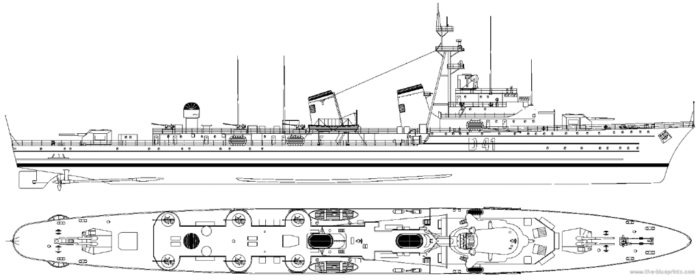
With the slow progress of construction, slipping from 1947-48 to 1951 onwards being a guarantee they would obsolete at completion, it was decided to radically alter the last two (second batch) after it was decided to cancel the first batch in 1953. Both were towed from Ferrol to Cartagena, cut in half lengthwise to widen them (but they were also lenghtened) so to resolve stability issues on Oquendo. And then started the Spanish quest for new weaponry and sensors, at first to British companies, but the government opposed this, considering the country was still a dictactorship. It was decided to mount a FRAM II system, which was the new trend on US destroyers at the time, amidst warmer relations with the US.
There were design amendments, reading of the features of Roger de Lauria and Marqués de la Ensenada would indicate that these were modern and well-equipped ships for their time, at least on paper. Despite the best conversion efforts, these ships made similar mistakes as the previous Audaz-class destroyer, the original power plant and machinery was kept. As a result, despite being the first ships built in Spain that were equipped with advanced electronic warfare equipment, helicopter facilities, a complete anti-submarine warfare combat system, including variable depth sonar, these ships were limited in their operational capacity from the beginning. Moreover, the enormous amount of resources put into this project prevented the funding and addressing of other possible improvement programs.
Hull and general design
These ships were a mixbag, but let’s focus on the Oquendo first. When completed in May 1963, she looked like indeed a post-modern Le Hardi class, with the same arounded bridge, classic two-step hull with a long forcastle ending aft of the bridge and mast, and clipper bow, two raked funnels, a tripod mast very similar to French designs at the time. The armament placement depended of the two main turrets, with superfiring hedkehogs and amidshipn, side Bofors AA, plus fixed tubes as revised, for US homing torpedoes.
As rebuilt the Roger de Lauria class leaned towards the Gearing class, with its bridge very close, and artillery management (see later) but still a tripid mast, albeit larger. Space was spared for an helipad aft, and instead of a foecastle they had a continuouys hull with a lower aft poop for the VDS. Completely different animals. The only point that did not changed was their prewar machinery.
Powerplant
The only point that was not change from the oirigin was their two shafts Rateau geared steam turbines coupled with Bretagne steam boilers. Originally this was sufficient to propel them to 32.5 knots (60.2 km/h; 37.4 mph) and as modernized, 31 knots (57 km/h; 36 mph) for a range of 3,200 nmi (5,900 km; 3,700 mi) at 20 knots (37 km/h; 23 mph). The adoption of Rateau/Bretagne propulsion system was unfortunatelya bad decision in retrospect being of low reliability and high complexity. Coupled with the limits of Spanish shipbuilding at the time, this led to countless issues for these vessels. Sometimes the turbines broke down, and when they were not, boilers had issues. This caused Oquento to be retired after a mere dozen of service years. The two other soldiered on until the 1980s, but their machinery issues plagues their active life and caused them numerous hours in repairs rather than in active service.
Othr than that, the refitted Roger de Lauria was slower as expected at 31 knots, and perhaps c29 at the end of their career. Still, they were better sea boats than the previous Oquendo but had stabilities issues nonetheless.
Armament
Oquendo was completed with her modified armament of two twin 120 mm/50 cal. DP cannon fore and aft, six 40 mm/70 cal. Bofors 40 mm gun and two Mk32 torpedo 533 mm (21.0 in) and two Mk11 Hedgehog ASW mortar, located fore and aft on superfiring positions. This was changed for the De Lauria class (see below).
Main
The twin 120 mm/50 NG53 DP of Oquendo were a Spanish semi-auto design with a muzzle velocity of 850 mps, 25 kg HE shell fired at 15 rpm, at a range of 20 km, perhaps 6000 m effective ceiling.
Little data available (more there), considered not a successful design. They were derived from the guns carried by the Pizarro class gunboats.
On the Oquendo class, the choice of the well-proven 5-in/38 twin Mark 12 was a no-brainer. Two located forward, one replacing the former hedgehog, one aft.
Mark 11 Hedgehog
The two Mk11 Hedgehog ASW mortar were located on the fore superfiring and aft superfiring decks. They had excellent arcs of fire. The Mark 11 was an allied WW2 design produced both in the US and Britain, with 24 propelled bombs making for a circular pattern measuring 200 feet (60 m) in diameter out to a range of about 188 yards (172 m). In 1963 they were obsolete against new types of Soviet submarines, notably 30 kts capable SSNs.
AA guns
The 6 Bofors AA 40 mm/70 SP 48 were apparently located all on single mounts on amidship upper positions, a pair between funnels, and the two remainder aft the the second funnel.
They were essentually kept for the modernized De Lauria class, as four single 20mm/70 AA guns on auutomated mounts and radar guided.
Torpedoes
The Ocquendo class had originally two Mark 32 torpedo tubes launchers Mark 4 amidships. This US model weighted 700 pounds for 83 inches long (2,10 m) and 19 in (480 mm) diameter, 25.4-in fins (63 cm). Officially classed as 325 mm ASW torpedoes. Effective firing range was 9600 yards, 24-minute Helix search carrying a 107 pounds HBX warhead with a Mk 19 Mods 4 and 11 contact exploder at 12 knots.
After modernization, these became two triples 325 mm Mk32 launched Mk44/Mk46, located amidship whereas the former Mark 4 tubes were replaced by 533 mm Mk25 tubes operating the ASW Mk-37 model.
This “short” model weighted 1,430 pounds (650 kg) for 135 inches (3.4 m) long, 19 inches (480 mm) real caliber, 23,000 yards (21 km) range at 17 knots, 9.1 km at 26 knots and carrying the powerful Mk 37 Mod 0, HBX-3 330 pounds warhead with Mk 19 contact exploder. Top speef was 17 knots (31 km/h), 26 knots (48 km/h) and it used a Gyroscope for her initial run to the target, the switched to passive sonar and Doppler active sonar homing for the terminal run.
Sensors
When completed in 1963, Oquendo had a type 262P, type 275M, type 293Q, SNW-10 radars, and the QHBa sonar.
-British Marconi SNW-10 2-D air warning radar
-British Type 293Q surface radar
-British QHB scanning sonar.
-Vickers-Armstrong fire control radar assisted 275M (120 mm guns)
-Vickers-Armstrong fire control radar type 262P (40 mm AA guns)
Roger de Lauria revision
AN/SPS-10F search radar
1959 2D FRq C Band PRF 650 Hz Bwt 1.9° × 16° Pwt 1.3 µs PP 280 kW
AN/SPS-40 A air-search radar
1961 2D Air-search. Frq 400-450 MHz, UHF band RPM 7.5 rpm (long-range mode), 15 rpm (low flier detection mode), Range 250 nmi, size 140″ x 214″, 19° elevation, beam width 10.5° PP 200/300 kW
Decca RM 426 navigation radar
No data. French radar.
AN/SQS-32C and AN/SQA-10 sonars
Minehunting sonar set (MSS) is a variable-depth mine-hunting sonar system originally developed by Raytheon and Thales Underwater Systems (formerly Thomson Marconi Sonars).
The AN/SQA-10 is a Variable depht Sonar (VDS)
Mk 37 fire control director with Mk 25 radar
Standard WW2 system for the 5-in/38 main guns.
AN/WLR-1
US standard EW system fitted after her last 1980s refit.
Helicopter
The ships had an helipad but no hangar so operations were limited in time. They operated either the Hughes-369 ASW1 or Hughes 500 models, which were small, compact and fast, but had limited capabilities overall.
⚙ Oquendo specifications |
|
| Displacement | 2,585 tonnes standard, 3,005 tonnes full load |
| Dimensions | 116.5 x 11.1 x 3.8 (328 x 36 x 11 feets) |
| Propulsion | 2 shafts Rateau GT turbines, 3 3-drum boilers, 60,000 shp |
| Speed | 39 knots |
| Range | range 5000nm/15kts |
| Armament | 2×2 4.7in/50 DP, 6x 40mm AA, 2 hedgehog, 2 Torpedo racks |
| Sensors | Radar Type 262, 275, 293, SNW-10, sonar QHBa |
| Air Group | |
| Crew | |
A rocky construction and De Lauria 1963 revision
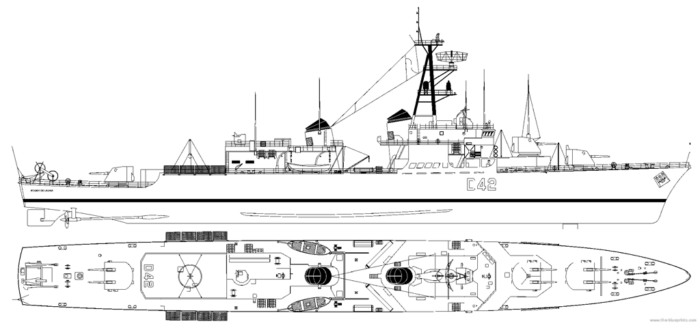
The Oquendos were, from the start Spanish designers’s worst nightmare. The process took 15 years after material was procured, and at some point assistance was asked from Ateliers de Bretagne in 1955 to complete the power plant, while the boilers had to be remade and modified several times. With such slow progress, it was decided to radically modified the two other sister-ship as their armaments and electronics did not match the reality of the time. They were from Ferrol to Cartagena, cut in half lengthwise to widen them and reduce stability issues while new weaponry was to be procured as well as new sensors.

Roger de Lauria in 1979 (conways)
⚙ De Lauria specifications |
|
| Displacement | 3,012 tonnes standard, 3,785 tonnes Fully load |
| Dimensions | 119.3 x 13 x 5.6 (391 x 42 x 18 feets) |
| Propulsion | 2 shafts Rateau GT turbines, 3 3-drum boilers, 60,000 shp |
| Speed | 31 knots |
| Range | Oil 700 tonnes, 5000nm/15kts |
| Armament | 3×2 5-in/38 DP, 2x 21-in TTs, 2×3 12.75 in TTs, . |
| Sensors | Radar SPS-10, SPS-37/40, RM-326 FCR Mk.25/28, SQS-28/32C, SQS-10 sonar. |
| Air Group | 1 helicopter, helipad, no hangar |
| Crew | 318 |
Negociations with the British failed, and then the staff turned to the US, ultimately to purchase the entire FRAM II system, to be applied to De Lauria, making her a clone of the Gearing FRAM (albeit with lackluster machinery). At the end of the process, on paper the new Roger de Lauria and Marqués de la Ensenada seemed well-equipped for their time, but similar mistakes were yet made with their original power plant and machinery kept, married with a state-of-the-art electronic warfare system and helicopter facilities, plus a modern and well balanced anti-submarine warfare capabilities with a variable depth sonar. Considerable resources allocated on class alone however prevented later improvements.
In the end, the three Oquendo class had short careers, of 15, 13, and 18 years respectively, with average to mediocre performance in service. In 1981, Marqués de la Ensenada was to be decommissioned, but when damaged in Santander by an ETA bomb it was decided to repair and maintain her until 1988, although no longer relevant. She was never upgraded with a missile system Meroka CIWS.
Back in 1957 whereas agreeements were made for US airbases in Spain and the naval base at Rota, there was an MDAP plan for the transfer of the ex-Fletcher class Lepanto, Almirante Ferrándiz, Almirante Valdés, Alcalá Galiano and Jorge Juan. Later, as the Oquendo class proved so mediocre, in 1972 five ex-Gearing FRAM II were transferred (they became the first missile destroyers in Spanish service, with ASROC) while in 1970 a licence was purchase to produce Knox class frigates in Spain, also missile-equipped. The Oquendo class proved the worst fiasco in the history of the Spanish Armada. From there, local construction (which was prior to WWI British-influenced) became heavily influenced by US designs. The Santa Maria class Frigates of the 1980s for example were Spanish made Oliver Hazard Perry ships, and the 2000s lauded Alvaro de Bazan class Frigates were AEGIS class destroyers now seen as very successful ships and a model of perfect US destroyer designs adaptation to local needs.
Spain would have better luck with smaller ships such as relatively successful frigates such as the Descubierta class.
Career of the Oquendo class
From an operational point of view, D-41 was assigned to the 21st Escort Squadron of Cartagena, along with the Lepanto Class destroyers (“The five Latinos”) whereas D-42 and D-43 were assigned to Ferrol-based 11th Escort Squadron, along with the Churruca Class destroyers (former Gearing FRAM II). D-43 visited Naples, Casablanca and Portsmouth in 1971, whereas she was bombed by ETA.
D-40, along with the Audaz and the D-class submarines were the most mediocre and ruinous projects that the Navy faced in the 20th century, a product of their time and the conditions of Spain in the postwar Franco era.
 Oquendo (D-41)
Oquendo (D-41)

Laid down at Bazán, Ferrol on 15 Jul. 1951, launched 5 Sep. 1956 completed on 22 May 1963. She was decommissioned on 2 Nov. 1978.
It was assigned to the 21st Escort Squadron based in Cartagena along with the Lepanto class destroyers.
In September 1964, she participated in maneuvers in the Cantabrian Sea.
On January 27, 1965 she took part with the North Naval Group in military maneuvers on the Galician coast, in which she flew the insignia of Rear Admiral Mario Romero Abella.
On the occasion of naval week, she participated in a landing drill in Almería on July 6, 1971.
In November 1973, she remained in San Sebastián during the visit to the city of the Princes of Spain Juan Carlos de Borbón y Borbón and Sofia of Greece and Denmark.
On October 16, 1974, it set sail escorting the LST Velasco (L-11), Martín Álvarez (L-12) and the LSD Galicia (L-31) from Cádiz to El Aaiún, where it arrived on the 19th of the same month. , transporting the “Alcázar de Toledo” Armored Infantry Regiment No. 61.
She was decommissioned and scrapped prematurely in 1978 due to problems with her propulsion system and her poor stability.
 Roger de Lauria (D-42)
Roger de Lauria (D-42)
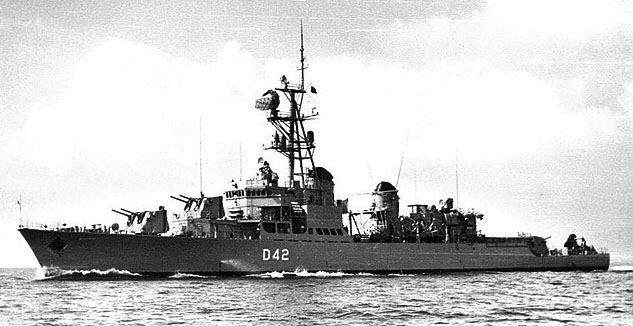
Roger de Lauria was the second laid down at Bazán, Ferrol/Cartagena on 4 Sep. 1951. She was launched on 12 Nov. 1958 and completed on 29 Aug. 1967, commissioned on 30 May 1969. She was assigned to the 11th Escort Squadron, with, homeported to the Ferrol naval base with the Churruca class destroyers, more capable Gearing FRAM II class destroyers just delivered via MDAP. The then princes of Spain, Juan Carlos de Borbón y Borbón and Sofía of Greece and Denmark embarked on this destroyer in Malaga on September 19, 1970 for a cruise to Melilla, to participate in commemorative events related to the Spanish Legion.
On August 9, 1978, she participated with the frigates Baleares and Extremadura, destroyer Lepanto, aircraft carrier Dédalo wit the submarine USS Shark in anti-submarine exercises in Cartagena. Nothing more to report. She was decommissioned on 15 Jan. 1982.
 Marqués de la Ensenada (D-43)
Marqués de la Ensenada (D-43)
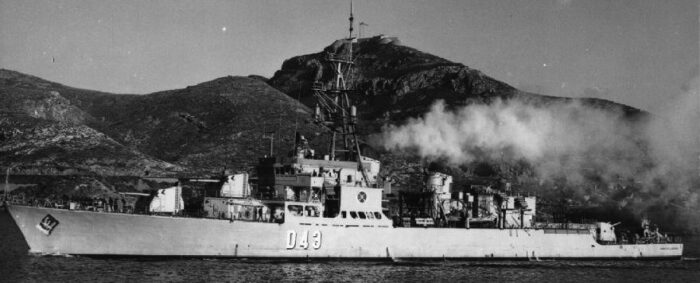
Marqués de la Ensenada was the first to be ordered at Bazán, Ferrol in Cartagena on 4 Sep. 1951, launched on 15 Jul. 1959 and completed on 2 Mar. 1968, but only commisioned on 10 Sep. 1970. Marqués de la Ensenada was assigned with Roger de Lauria to Ferrol, 11th Escort Squadron and FRAM II Churruca Class. In 1971, the “Marquis of Ensenada” visited Naples, Casablanca and Portsmouth.
On October 2, 1981, when about to be decommissioned, she was bombed in Santander by ETA. The bomb drtonated on her waterline, created a 3 by 2.5 m gush in the fourth boilers compartment and massive flooding, stipped by the bulkheads. In order to avoid the image of decommissioning a ship just after a terrorist attack and publicity gained by ETA, it was decided to postpone her decommission and keep her after repairs as long in service as possible. The repairs cost amounted to 10 million pesetas (about €247,000 in 1995), until her final decommission, made official, of October 20, 1988, and thus making her the oldest in her class with 18 years of service. The damaged plating was cut out to be exposed as her bell at the Ferrol Museum.
Read More/Src
Books
Conway’s all the worlds fighting ships 1947-95
Los destructores “Roger de Lauria” y “Marqués de la Ensenada”. La Vanguardia 2 November 1968.
Bedoya, J.G (3 October 1981). “La policía de Santander atribuye a ETA Militar el sabotaje terrorista contra el “Marqués de la Ensenada””. El País 2017.
Links
kbismarck.org/
navypedia.org/
en.wikipedia.org/
es.wikipedia.org/
archive.ph elpais.com/
commons.wikimedia.org
abc.es/
web.archive.org ejercito.mde.es
navy-radio.com/manuals donars pdf
Videos
Model Kits
Non found !

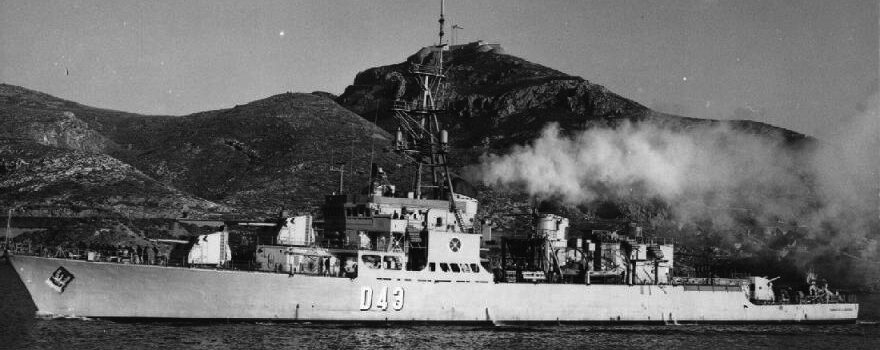
 Latest Facebook Entry -
Latest Facebook Entry -  X(Tweeter) Naval Encyclopedia's deck archive
X(Tweeter) Naval Encyclopedia's deck archive Instagram (@navalencyc)
Instagram (@navalencyc)





 French Navy
French Navy Royal Navy
Royal Navy Russian Navy
Russian Navy Armada Espanola
Armada Espanola Austrian Navy
Austrian Navy K.u.K. Kriegsmarine
K.u.K. Kriegsmarine Dansk Marine
Dansk Marine Nautiko Hellenon
Nautiko Hellenon Koninklije Marine 1870
Koninklije Marine 1870 Marinha do Brasil
Marinha do Brasil Osmanlı Donanması
Osmanlı Donanması Marina Do Peru
Marina Do Peru Marinha do Portugal
Marinha do Portugal Regia Marina 1870
Regia Marina 1870 Nihhon Kaigun 1870
Nihhon Kaigun 1870 Preußische Marine 1870
Preußische Marine 1870 Russkiy Flot 1870
Russkiy Flot 1870 Svenska marinen
Svenska marinen Søværnet
Søværnet Union Navy
Union Navy Confederate Navy
Confederate Navy Armada de Argentina
Armada de Argentina Imperial Chinese Navy
Imperial Chinese Navy Marinha do Portugal
Marinha do Portugal Mexico
Mexico Kaiserliche Marine
Kaiserliche Marine 1898 US Navy
1898 US Navy Sovietskiy Flot
Sovietskiy Flot Royal Canadian Navy
Royal Canadian Navy Royal Australian Navy
Royal Australian Navy RNZN Fleet
RNZN Fleet Chinese Navy 1937
Chinese Navy 1937 Kriegsmarine
Kriegsmarine Chilean Navy
Chilean Navy Danish Navy
Danish Navy Finnish Navy
Finnish Navy Hellenic Navy
Hellenic Navy Polish Navy
Polish Navy Romanian Navy
Romanian Navy Turkish Navy
Turkish Navy Royal Yugoslav Navy
Royal Yugoslav Navy Royal Thai Navy
Royal Thai Navy Minor Navies
Minor Navies Albania
Albania Austria
Austria Belgium
Belgium Columbia
Columbia Costa Rica
Costa Rica Cuba
Cuba Czechoslovakia
Czechoslovakia Dominican Republic
Dominican Republic Haiti
Haiti Hungary
Hungary Honduras
Honduras Estonia
Estonia Iceland
Iceland Eire
Eire Equador
Equador Iran
Iran Iraq
Iraq Latvia
Latvia Liberia
Liberia Lithuania
Lithuania Mandchukuo
Mandchukuo Morocco
Morocco Nicaragua
Nicaragua Persia
Persia San Salvador
San Salvador Sarawak
Sarawak Uruguay
Uruguay Venezuela
Venezuela Zanzibar
Zanzibar Warsaw Pact Navies
Warsaw Pact Navies Bulgaria
Bulgaria Hungary
Hungary

 Bundesmarine
Bundesmarine Dutch Navy
Dutch Navy Hellenic Navy
Hellenic Navy Marina Militare
Marina Militare Yugoslav Navy
Yugoslav Navy Chinese Navy
Chinese Navy Indian Navy
Indian Navy Indonesian Navy
Indonesian Navy JMSDF
JMSDF North Korean Navy
North Korean Navy Pakistani Navy
Pakistani Navy Philippines Navy
Philippines Navy ROKN
ROKN Rep. of Singapore Navy
Rep. of Singapore Navy Taiwanese Navy
Taiwanese Navy IDF Navy
IDF Navy Saudi Navy
Saudi Navy Royal New Zealand Navy
Royal New Zealand Navy Egyptian Navy
Egyptian Navy South African Navy
South African Navy






























 Ukrainian Navy
Ukrainian Navy dbodesign
dbodesign